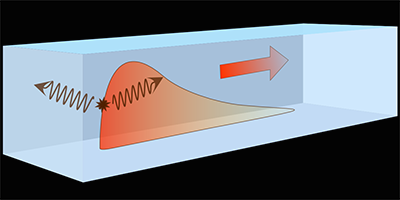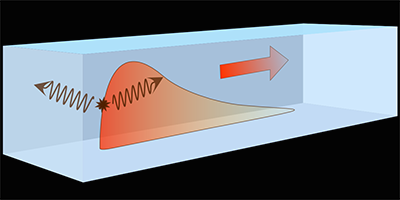Creating Hawking Radiation in the Lab?
Researchers would love to be able to observe the inner workings of black holes, but the measurable information escaping from them is scant. Theory says, for instance, that the Hawking radiation they might release would be so faint that it would disappear in the cosmic microwave background. However, a similar phenomenon could be observed in laboratory analogs of black holes, based on wave phenomena described by the same equations. Writing in Physical Review A, Stefano Finazzi at Université Paris Diderot-Paris 7, France, and Iacopo Carusotto at the University of Trento, Italy, analyze recent controversial claims of Hawking-radiation detection in optical experiments. Their analysis clarifies why such claims are not yet conclusive and suggests how improved experiments may deliver an unequivocal signature of Hawking radiation.
Optical analogs of black holes are based on the idea that event horizons can occur when a short laser pulse propagates in a nonlinear medium, modifying its index of refraction in the same way that gravity changes spacetime. In this situation, the leading edge of the pulse could correspond to a black hole horizon (no light can escape it), while the trailing edge to a white hole horizon (a boundary that nothing can enter). Both horizons would be associated with the emission of radiation bearing the characteristics of Hawking radiation: correlated photon pairs, one inside and one outside the horizon. Focusing on the white hole horizon, the authors show the calculated emission agrees qualitatively with that observed in previous experiments, but the detailed analysis indicates that several competing effects could lead to similar experimental signatures. The researchers suggest that an ultimate proof of Hawking radiation could be gathered by measuring the nonclassical correlations between the emitted photons. – Matteo Rini





